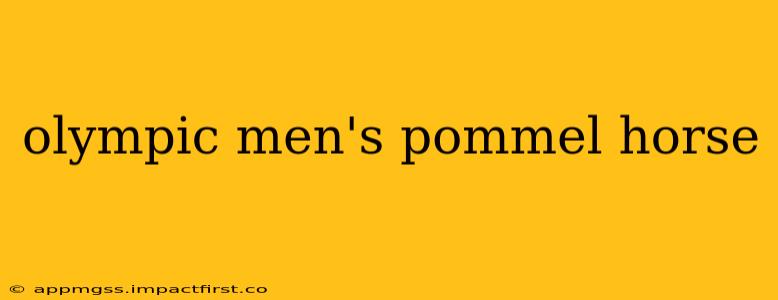The Olympic men's pommel horse is a breathtaking display of strength, balance, and precision. This demanding apparatus requires years of dedicated training to master, and the routines performed at the Olympic level are truly awe-inspiring. This article delves into the intricacies of this event, exploring its history, techniques, and the key elements that separate the champions from the rest.
What are the main skills performed on the pommel horse?
The pommel horse routine is a complex choreography of movements, all performed while maintaining exceptional balance and control. Key skills include: circles (both forward and backward, with variations in size and speed), flares, scissors, handstands, and transitions between these elements. The difficulty of a routine is determined by the combination and execution of these skills, with higher-level routines incorporating more complex and interconnected movements. Points are awarded based on the difficulty of the routine and the execution of each skill. A clean, powerful routine with flawless transitions is essential for a high score.
How are pommel horse routines judged?
Judging in the pommel horse event is rigorous and focuses on both the difficulty and execution of the routine. Judges assess various aspects, including:
- Difficulty: The D-score reflects the complexity and originality of the routine's elements. More challenging skills and combinations earn a higher D-score.
- Execution: The E-score evaluates the gymnast's performance quality, considering factors like form, stability, fluidity of movements, and the overall control throughout the routine. Deductions are given for any errors, such as falls, wobbles, or incomplete movements.
The final score is the sum of the D-score and the E-score. Even minor imperfections can significantly impact the final score, highlighting the immense precision required.
What makes a great pommel horse gymnast?
A truly exceptional pommel horse gymnast possesses a unique blend of physical attributes and skills:
- Exceptional Strength: Maintaining balance and executing complex movements on the pommel horse requires incredible upper body strength, core strength, and grip strength.
- Superb Balance and Coordination: Maintaining balance on such an unstable apparatus is crucial. A gymnast needs exceptional coordination and proprioception (awareness of body position in space).
- Flexibility: While not as emphasized as in other gymnastics events, flexibility aids in executing certain skills and transitions more efficiently and gracefully.
- Mental Fortitude: The pressure of competing at the Olympic level, coupled with the demanding nature of the pommel horse, requires incredible mental strength and focus.
What are some common mistakes made on the pommel horse?
Common mistakes often lead to deductions and can significantly impact a gymnast's score. These include:
- Loss of Balance: This is a frequent error, resulting in wobbles or falls, which can lead to substantial point deductions.
- Incomplete or Inaccurate Movements: Failing to fully execute a skill or performing it with poor form will also reduce the score.
- Lack of Fluidity in Transitions: Jerky or uncontrolled transitions between elements detract from the overall aesthetic and technical quality of the routine.
What are some of the most memorable pommel horse routines in Olympic history?
Olympic history is filled with memorable pommel horse performances. While listing all would be impossible, notable gymnasts and routines stand out for their difficulty, artistry, and impact. Researching past Olympic Games reveals iconic performances that continue to inspire aspiring gymnasts. The names of these gymnasts often become synonymous with excellence in the sport.
How can I learn more about pommel horse gymnastics?
To delve deeper into the world of pommel horse gymnastics, exploring online resources dedicated to gymnastics is a great starting point. Many websites and videos provide detailed breakdowns of skills, routines, and judging criteria. Watching videos of Olympic routines can offer invaluable insights into the technical aspects and the artistry involved. Furthermore, local gymnastics clubs often offer lessons and training for those interested in learning the fundamentals of pommel horse.
This comprehensive overview provides a solid foundation for understanding the intricacies and challenges of the Olympic men's pommel horse event. From the fundamental skills to the judging criteria and the attributes of a champion, this exploration highlights the dedication, skill, and artistry required to excel in this demanding discipline.
